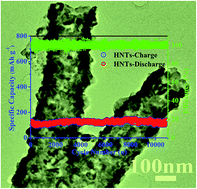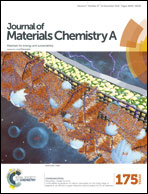Mesoporous Ni-doped MnCo2O4 hollow nanotubes as an anode material for sodium ion batteries with ultralong life and pseudocapacitive mechanism†
Abstract
Mesoporous Ni-doped MnCo2O4 hollow nanotubes (denoted as MCNO-HNTs) are successfully prepared through simple single-nozzle electrospinning combined with thermal treatment. MCNO-HNTs obviously exhibit a hollow structure and are assembled by a lot of small nanoparticles. When used as an anode material for sodium-ion batteries (SIBs), this electrode exhibits remarkable capacity retention of 81% at 1 A g−1 even after 11 000 cycles. The outstanding electrochemical performance can be attributed to the unique hollow mesoporous structure that alleviates stress caused by large volume changes, suppresses the agglomeration of the pulverized nanoparticles, and facilitates the transfer of electrons and electrolyte ions during prolonged cycling. Furthermore, the pseudocapacitive behavior of this material also effectively improves the electrochemical reaction kinetics. Therefore, due to the simple single-nozzle electrospinning technique and high electrochemical performance, mesoporous MCNO-HNTs have great potential as an anode material for rechargeable SIBs.


 Please wait while we load your content...
Please wait while we load your content...